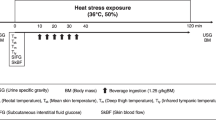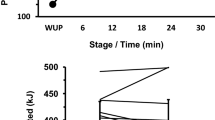Abstract
Purpose
This study examined the thermoregulatory response and ergogenic effects of ice slurry (ICE) ingestion in hot environments with high and low relative humidity (RH).
Methods
Eight males completed four trials in a crossover manner in dry (DRY: 34.7 ± 0.2 °C, 38 ± 2%RH) and humid heat (HUM: 34.8 °C ± 0.2 °C, 80 ± 1%RH). They ingested 8.0 g·kg−1 of ICE (0.0 °C) or 37.5 °C water (CON) during 30 min before exercise, and three aliquots (3.2 g·kg−1) of ICE or CON during 45-min cycling at 50%\({\dot{\text{V}}}\)O2peak, followed by cycling to exhaustion at 80%\({\dot{\text{V}}}\)O2peak (TTE). Body core temperature (Tcore), mean skin temperature (Tsk), heart rate (HR), thermal comfort, thermal sensation and rating of perceived exertion (RPE) were measured.
Results
Relative to CON, ICE improved TTE by 76.5 ± 96.5% in HUM and 21.3 ± 44.9% in DRY (p = 0.044). End-exercise Tcore was lower in ICE versus CON in DRY (37.8 ± 0.4 °C versus 38.1 ± 0.3 °C, p = 0.005) and HUM (38.8 ± 0.4 °C versus 39.3 ± 0.6 °C, p = 0.004). ICE decreased HR, heat storage and heat strain index only in DRY (p < 0.001–0.018). ICE improved thermal sensation and comfort in DRY and HUM (p < 0.001–0.011), attenuated RPE in HUM (p = 0.012) but not in DRY (p = 0.065).
Conclusion
ICE tended to benefit performance in humid heat more than in dry heat. This is likely due to the reduced extent of hyperthermia in dry heat and the relative importance of sensory inputs in mediating exercise capacity.







Similar content being viewed by others
Data availability
All data generated or analysed during this study are included in this published article.
Abbreviations
- BSA:
-
Body surface area
- C + R:
-
Combined heat exchange via convection and radiation
- Cp(fluid) :
-
Specific heat capacity of water
- Cp(ice) :
-
Specific heat capacity of ice
- Cres + Eres :
-
Convective and evaporative heat loss due to respiration
- DRY + CON:
-
37.5 °C water ingestion in hot and dry environment
- DRY + ICE:
-
Ice slurry ingestion in hot and dry environment
- E:
-
Evaporative heat loss
- Emax :
-
Evaporative capacity of the environment
- Ereq :
-
Evaporative requirement for heat balance
- fcl :
-
Clothing area factor
- h:
-
Combined convective and radiative heat transfer coefficient
- hc :
-
Convective heat transfer coefficient
- Hfluid :
-
Heat exchange with ingested fluid
- Hice :
-
Energy lost when ice melts
- Hprod :
-
Metabolic heat production
- HR:
-
Heart rate
- HRdiff :
-
Difference in heart rate between the end of the exercise and immediately before the start of the exercise
- HRmean :
-
Mean heart rate during exercise
- HRpeak :
-
Peak heart rate during exercise
- HSI:
-
Heat strain index
- HUM + CON:
-
37.5 °C water ingestion in hot and humid environment
- HUM + ICE:
-
Ice slurry ingestion in hot and humid environment
- ICE:
-
Ice slurry
- LR:
-
Lewis Relation
- LSR:
-
Local sweat rate
- M:
-
Metabolic energy expenditure
- massfluid :
-
Mass of ingested fluid
- massice :
-
Mass of ingested ice
- Pa :
-
Ambient vapour pressure
- Psk :
-
Saturated vapour pressure at the skin
- Rcl :
-
Heat transfer resistance of clothing
- RER:
-
Respiratory exchange ratio
- RPE:
-
Rating of perceived exertion
- S:
-
Body heat storage
- Ta :
-
Air temperature
- Tcore :
-
Body core temperature
- Tfluid :
-
Ingested fluid temperature
- Tsk :
-
Weighted mean skin temperature
- TTE:
-
Time-to-exhaustion
- USG:
-
Urine specific gravity
- v:
-
Air velocity
- \({\dot{\text{V}}}\)CO2 :
-
Carbon dioxide production
- \({\dot{\text{V}}}\)̇O2 :
-
Oxygen uptake
- \({\dot{\text{V}}}\)̇O2peak :
-
Peak oxygen uptake
- W:
-
Work output
- WBSR:
-
Whole body sweat rate
References
Belding H, Heating TH (1955) Index for evaluating heat stress in terms of resulting physiological strains. Heat Piping Air Cond 27(8):129–136
Bongers CCWG, De Korte JQ, Eijsvogels T (2021) Infographic Keep it cool and beat the heat: cooling strategies for exercise in hot and humid conditions. Brit J Sports Med. 55(11):643–644. https://doi.org/10.1136/bjsports-2020-102294
Choo HC, Peiffer JJ, Lopes-Silva JP, Mesquita RNO, Amano T, Kondo N, Abbiss CR (2019) Effect of ice slushy ingestion and cold water immersion on thermoregulatory behavior. PLoS ONE 14(2):e0212966. https://doi.org/10.1371/journal.pone.0212966
Cohen, J. (1988). Statistical power analysis for the behavioral sciences (2nd eds). Lawrence Erlbaum Associates.
Cramer MN, Jay O (2019) Partitional calorimetry. J Appl Physiol 126(2):267–277. https://doi.org/10.1152/japplphysiol.00191.2018
Gisolfi CV, Wenger CB (1984) Temperature regulation during exercise: old concepts, new ideas. Exerc Sport Sci Rev 12(1):339–372
Ihsan M, Landers G, Brearley M, Peeling P (2010) Beneficial effects of ice ingestion as a precooling strategy on 40-km cycling time-trial performance. Int J Sports Physiol Perform 5(2):140–151. https://doi.org/10.1123/ijspp.5.2.140
Jay O, Morris NB (2018) Does cold water or ice slurry ingestion during exercise elicit a net body cooling effect in the heat? Sports Med 48:17–29. https://doi.org/10.1007/s40279-017-0842-8
Kenefick RW, Cheuvront SN (2012) Hydration for recreational sport and physical activity. Nutr Rev 70(2):S137–S142. https://doi.org/10.1111/j.1753-4887.2012.00523.x
Kerslake DM (1972) The stress of hot environments. Cambridge University Press
Morris NB, Bain AR, Cramer MN, Jay O (2014) Evidence that transient changes in sudomotor output with cold and warm fluid ingestion are independently modulated by abdominal, but not oral thermoreceptors. J Appl Physiol 116:1088–1095. https://doi.org/10.1152/japplphysiol.01059.2013
Morris NB, Coombs G, Jay O (2016) Ice slurry ingestion leads to a lower net heat loss during exercise in the heat. Med Sci Sports Exerc 48(1):114–122. https://doi.org/10.1249/MSS.0000000000000746
Naito T, Ogaki T (2016) Comparison of the effects of cold water and ice ingestion on endurance cycling capacity in the heat. J Sport Health Sci 6(January):111–117. https://doi.org/10.1016/j.jshs.2015.12.002
Naito T, Ogaki T (2017) Comparison of the effects of cold water and ice ingestion on endurance cycling capacity in the heat. J Sport Health Sci 6(1):111–117. https://doi.org/10.1016/j.jshs.2015.12.002
Nybo L, Nielsen B (2001) Perceived exertion is associated with an altered brain activity during exercise with progressive hyperthermia. J Appl Physiol 91(5):2017–2023. https://doi.org/10.1152/jappl.2001.91.5.2017
Onitsuka S, Nakamura D, Onishi T, Arimitsu T, Takahashi H, Hasegawa H (2018) Ice slurry ingestion reduces human brain temperature measured using non-invasive magnetic resonance spectroscopy. Sci Rep 8(1):4–10. https://doi.org/10.1038/s41598-018-21086-6
Racinais S, Ihsan M, Taylor L, Cardinale M, Adami PE, Alonso JM, Bouscaren N, Buitrago S, Esh CJ, Gomez-Ezeiza J, Garrandes F, Havenith G, Labidi M, Lange G, Lloyd A, Moussay S, Mtibaa K, Townsend N, Wilson MG, Bermon S (2021) Hydration and cooling in elite athletes: relationship with performance, body mass loss and body temperatures during the Doha 2019 IAAF World Athletics championships. Brit J Sports Med 55:2020–103613. https://doi.org/10.1136/bjsports-2020-103613
Roberts MF, Wenger CB, Stolwijk JAJ, Nadel ER (1977) Skin blood flow and sweating changes following exercise training and heat acclimation. J Appl Physiol Respirat Environm Exer Physiol 43(1):133–137. https://doi.org/10.1152/jappl.1977.43.1.133
Shiojiri T, Shibasaki M, Aoki K, Kondo N, Koga S (1997) Effects of reduced muscle temperature on the oxygen uptake kinetics at the start of exercise. Acta Physiol Scand 159(4):327–333. https://doi.org/10.1046/j.1365-201X.1997.00120.x
Siegel R, Maté J, Watson G, Nosaka K, Laursen PB (2012) Pre-cooling with ice slurry ingestion leads to similar run times to exhaustion in the heat as cold water immersion. J Sports Sci 30(2):155–165. https://doi.org/10.1080/02640414.2011.625968
Yeo ZW, Fan PWP, Nio AQX, Byrne C, Lee JKW (2012) Ice slurry on outdoor running performance in heat. Int J Sports Med 33(11):859–866. https://doi.org/10.1055/s-0032-1304643
Acknowledgements
The experiments were carried out at Singapore Sport Institute. The authors wish to thank all the participants for volunteering.
Funding
No funds, grants, or other support was received for this study.
Author information
Authors and Affiliations
Contributions
HCC, MI, JLKW and SFB conceived and designed the research. HCC, DHWC, KMC, IT and JC conducted the study. HCC, DHWC and MI analysed the data and wrote the manuscript. All authors read and approved the manuscript.
Corresponding author
Ethics declarations
Conflict of interest
The authors have no conflicts of interest, financial or otherwise, to declare.
Ethical approval
All procedures performed in studies involving human participants were in accordance with the ethical standards of the institutional research committee and the 1964 Helsinki declaration and its later amendments or comparable ethical standards. This study was approved by Institutional Review Boards of Singapore Sport Institute (Reference number: PH-FULL-038) and Nanyang Technological University (Reference number: IRB-2021–242).
Informed consent
Informed consent was obtained from all participants included in the study.
Additional information
Communicated by Narihiko kondo.
Publisher's Note
Springer Nature remains neutral with regard to jurisdictional claims in published maps and institutional affiliations.
Rights and permissions
Springer Nature or its licensor (e.g. a society or other partner) holds exclusive rights to this article under a publishing agreement with the author(s) or other rightsholder(s); author self-archiving of the accepted manuscript version of this article is solely governed by the terms of such publishing agreement and applicable law.
About this article
Cite this article
Choo, H.C., Choo, D.H.W., Tan, I. et al. Effect of ice slurry ingestion on thermoregulatory responses during fixed-intensity cycling in humid and dry heat. Eur J Appl Physiol 123, 2225–2237 (2023). https://doi.org/10.1007/s00421-023-05235-y
Received:
Accepted:
Published:
Issue Date:
DOI: https://doi.org/10.1007/s00421-023-05235-y




